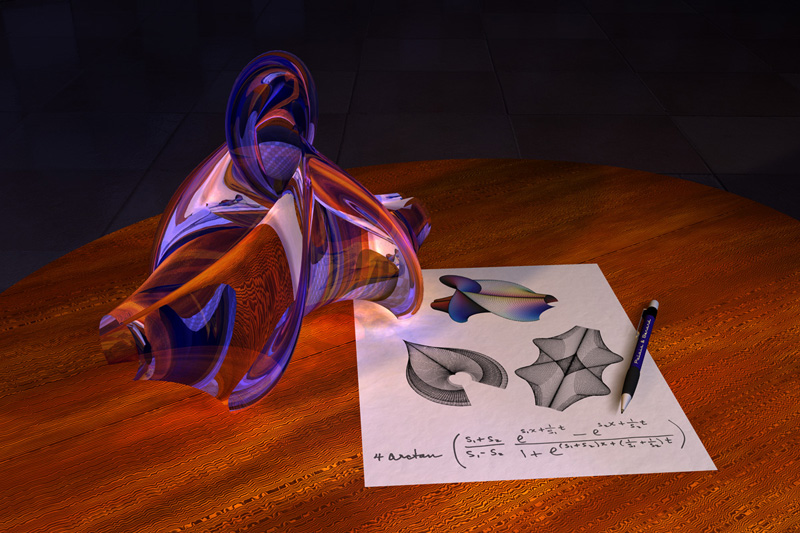
Kuen's Surface: A Meditation on Euclid, Lobachevsky, and Quantum Fields.
Mathematicians use symbols in many ways. In this illustration, which has the title "Kuen's Surface: A Meditation on Euclid, Lobachevsky, and Quantum Fields", we see on a piece of paper a formula made up of mathematical symbols. This formula is a particular solution of the so-called Sine-Gordon Equation, and like all solutions of that equation it describes an example of a very special kind of surface, called a pseudospherical or Lobachevskian surface. The pseudospherical surface described by the formula is a particularly beautiful one called Kuen's surface, and several two-dimensional projections of it are shown above the formula and the full three-dimensional Kuen surface is shown resting on the table-top.
What is remarkable about pseudospherical surfaces is that they have a geometry that satisfies all of Euclid's axioms for plane geometry except the Parallel Postulate, so Kuen's Surface itself is serving as a symbol of the 2000 years of futile attempts to prove the Parallel Postulate from the other axioms, attempts that ended in 1826 with Lobachevsky's remarkable discovery of the pseudospherical counter-examples. But another surprise was in the offing; a hundred years after the discovery of the intimate relation between the Sine-Gordon Equation and Lobachevskian surfaces, it turned out that the Sine-Gordon Equation was also a model of a Relativistic Quantum Field Theory, the kind of mathematical structure on which theoretical physicists base their most advanced and sophisticated theories of the structure of matter. So this illustration symbolizes two millennia of mathematical progress. The 3D mesh and the images on the paper sheet are produced with 3D-XplorMath, assembled and rendered in Carrara.
What is remarkable about pseudospherical surfaces is that they have a geometry that satisfies all of Euclid's axioms for plane geometry except the Parallel Postulate, so Kuen's Surface itself is serving as a symbol of the 2000 years of futile attempts to prove the Parallel Postulate from the other axioms, attempts that ended in 1826 with Lobachevsky's remarkable discovery of the pseudospherical counter-examples. But another surprise was in the offing; a hundred years after the discovery of the intimate relation between the Sine-Gordon Equation and Lobachevskian surfaces, it turned out that the Sine-Gordon Equation was also a model of a Relativistic Quantum Field Theory, the kind of mathematical structure on which theoretical physicists base their most advanced and sophisticated theories of the structure of matter. So this illustration symbolizes two millennia of mathematical progress. The 3D mesh and the images on the paper sheet are produced with 3D-XplorMath, assembled and rendered in Carrara.